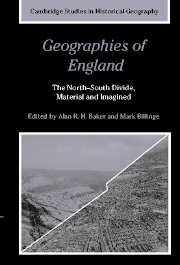Book contents
- Frontmatter
- Contents
- List of figures
- List of tables
- List of contributors
- Preface
- 1 Material and imagined geographies of England
- 2 The contemporary debate over the North–South divide: images and realities of regional inequality in late-twentieth-century Britain
- 3 Distressed times and areas: poverty, polarisation and politics in England, 1918–1971
- 4 Industry and identity: the North–South divide and the geography of belonging, 1830–1918
- 5 Divided by a common language: North and South, 1750–1830
- 6 South, North and nation: regional differences and consciousness in an integrating realm, 1550–1750
- 7 North–South dichotomies, 1066–1550
- 8 Cultural constructions of England's geography and history
- References
- Index
- Cambridge Studies in Historical Geography
6 - South, North and nation: regional differences and consciousness in an integrating realm, 1550–1750
Published online by Cambridge University Press: 10 December 2009
- Frontmatter
- Contents
- List of figures
- List of tables
- List of contributors
- Preface
- 1 Material and imagined geographies of England
- 2 The contemporary debate over the North–South divide: images and realities of regional inequality in late-twentieth-century Britain
- 3 Distressed times and areas: poverty, polarisation and politics in England, 1918–1971
- 4 Industry and identity: the North–South divide and the geography of belonging, 1830–1918
- 5 Divided by a common language: North and South, 1750–1830
- 6 South, North and nation: regional differences and consciousness in an integrating realm, 1550–1750
- 7 North–South dichotomies, 1066–1550
- 8 Cultural constructions of England's geography and history
- References
- Index
- Cambridge Studies in Historical Geography
Summary
Early modernity
Generally known as ‘the early modern period’, this span of time is identified by the onset of ‘modernity’: that is, the deployment of instrumental human reason in relationships with nature and people, eventually to create an incomparably more materially productive, intricately ordered and expansive world (Graham and Nash 2000: 1–7). Human lives, livelihoods and geographies began to change profoundly as people and institutions deliberately set out to improve material life and its natural, social and political settings. This quest for improvement required the communication of both abstract and instrumental knowledge, in written and other forms. Modernity is therefore not only a state of being, but also, necessarily, a communicated state of knowing: a text about itself. Because we can only deliberately maintain and sustain, or improve and progress, through the elucidation of relationships between past, present and future, modernity's texts are inevitably historical. People began to recount what others wanted (and what they wanted others) to know about their world as it actually was, and to explain how it was changing for better or worse.
Of course, such profound structural and conceptual changes cannot happen suddenly or synchronously, and a ‘late’ something else must also have existed in the period: which would be ‘feudalism’ according to conventional historical tags. What that and its geography were are the subject of the next chapter, but it is necessary in this one to be wary of looking only for the beginnings of what later became general.
- Type
- Chapter
- Information
- Geographies of EnglandThe North-South Divide, Material and Imagined, pp. 112 - 144Publisher: Cambridge University PressPrint publication year: 2004



